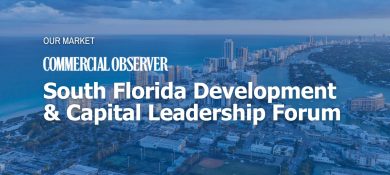In a sign that demand for South Florida’s trophy real estate assets persists despite economic volatility, I&G Miami, Inc. has purchased downtown Miami’s landmark Miami Tower office building from owner Blue Capital US East Coast Properties, L.P. for $105.5 million. Designed by renowned architect I.M. Pei and constructed in 1987, Miami Tower stands as one of the world’s most recognized office buildings thanks to its ever-changing palette of exterior lighting schemes.The transaction, which closed on December 17, 2010, ranks as the highest-valued real estate trade in the Miami market this year.Details of the sale were made public by Manny de Zarraga and Hermen Rodriguez of HFF (Holliday Fenoglio Fowler, L.P.) who represented seller Blue Capital US East Coast Properties, L.P. in the transaction.
Attorney Carey Stiss of Bilzin Sumberg Baena Price & Axelrod LLP served as legal counsel for the seller, which is affiliated with Atlanta- based Wealth Capital Investments, Inc. Attorney Carey Stiss of Bilzin Sumberg pointed out that among the challenges presented by this transaction, Miami Tower is situated atop a City of Miami-owned parking garage, meaning that the City’s consent was required to proceed with the closing.“In an economic climate where capital can be difficult to secure and transactions tend to encounter steep obstacles en route to closing, the sale and purchase of Miami Tower proves that institutional owners looking to add top-tier assets to their portfolios can still access financing and get deals done,” said Mr. Stiss. “The fact that this complex transaction closed on a relatively short timeline is an encouraging sign for would-be owners in the market to acquire premium commercial assets in South Florida.”
More details can be found in the Miami Herald’s front-page story below.
Investors make a bet on downtown Miami, buying tower for $106 million
The colorful Miami Tower, formerly called the CenTrust Tower, has been one of the iconic buildings in the Miami skyline. The building was sold recently to Chicago investors for $106 million.
Miami’s brightest building is helping beat back some of the gloom hanging over the city’s glutted office market, as Chicago investors make a big bet on downtown’s return to boom times. An affiliate of Jones Lang LaSalle recently paid $106 million for the 47-story Miami Tower, the 1987 building designed by I.M. Pei and famous for an exterior that changes color thanks to an elaborate lighting system. The price — a 25 percent increase over its last sale in 2003 — suggests renewed confidence in an office district suffering from depressed demand and too much supply.
“It’s a good sign that somebody believes long-term in the Miami market,” said Jay Caplin, managing principal of Steelbridge Capital in Miami, which sells and manages office properties. “The market has been largely stagnant.”
With its Friday sale, an office tower best known for cameos in nearly every filmed and televised shot of the Miami skyline continues its role as a proxy for the highs and lows of South Florida’s economy, too. Opened as CenTrust Tower, the 600,000-square-foot building was a monument to that bank’s rise in the go-go era of Miami’s financial markets in the 1980s. CenTrust chairman David Paul famously outfitted the penthouse offices with gold-plated faucets in the washrooms, marble walls and a luxe theater for executives. When the bank collapsed in the savings-and-loan crisis of the 1990s, the tower’s gilded trappings were an easy metaphor for corporate greed. Amid the recent financial meltdown, the tower lost Bank of America as its lead tenant when the bank pulled its name off the building and cleared out of three floors of offices in a consolidation move.
Now, with new owners, a top priority will be finding another name tenant — most likely a bank or similar financial institution, insiders said. Just as Wells Fargo signaled its ambitions for South Florida this year by securing the naming rights to the new Met Two office tower, a bank could broadcast a certain fiscal bravado by claiming Miami’s flashiest building.
“There are many banks — and many institutions in general — that are currently looking at space and reassessing their real estate strategy,” said Rashid Siahpoosh, senior vice president of Transwestern, the Miami company hired by new owners LaSalle Investment Management to market the tower to tenants. “Many are looking to heighten their branding by being attached to buildings.”
While a mark-up from the $85 million that previous owner Blue Capital paid for the tower in 2003, the $105 million sales price is far less than the building would have fetched just two years ago. In 2008, Japanese conglomerate Sumitomo paid $260 million for the Miami Center office tower next to the Intercontinental hotel. That deal amounted to $332 per square foot, compared to $175-a-foot for the smaller Miami Tower.
Carey Stiss, a Bilzin Sumberg lawyer who represented Miami Tower’s seller, Blue Capital, said investors were eager to scoop up Miami’s most recognizable building. “When we put it on the market in September, it drew a lot of interest,” Stiss said. “The building itself has a lot of value. The lighting adds some intrinsic value that’s hard to put a price on.”
After Bank of America left at the start of 2010, the renamed Miami Tower saw occupancy drop to just below 80 percent. Filling the vacant space is a challenge, given the arrival of two new office towers in Miami: Met Two and 1450 Brickell. A recent report by CB Richard Ellis estimated downtown Miami’s office buildings are about 75 percent full. That’s compared to about 95 percent full when the real estate crash gained speed in 2008.
“Downtown Miami is experiencing the highest vacancy rate seen in years,” the report said. Landlords “will need to offer aggressive terms to retain tenants and attract new tenants.”
While the lights are nice, LaSalle Investment managing director Ty Spearing said Miami Tower brings with it more practical advantages in a competitive market. With plans to extend MetroRail to Miami International Airport, having a MetroMover stop at the building will prove to be a key perk, Spearing said, as will the tower’s proximity to an I-95 exit. With “all the condo and office development downtown, traffic is becoming an issue,” he said. “We think that’s a net-positive for this building.”
The Chicago-based firm exited Miami’s commercial market in 2007 — before values crashed — when it sold the Courvosier Centre office complex on Brickell Key for a reported $150 million.
Spearing sees LaSalle’s return as well-timed, too. “I don’t know if we’re at the bottom,” he said. “But if we’re not at the bottom, I think we’re close.”







 See More Blogs
See More Blogs
Comments